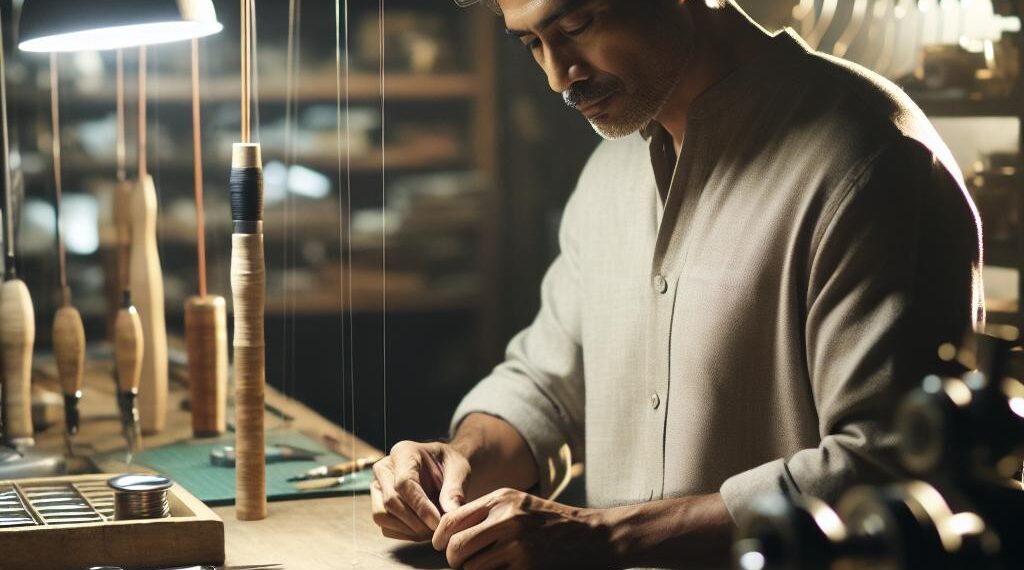Ever lost a prized catch because your rod just didn’t measure up? You’re not alone! Many anglers, both new and seasoned, grapple with gear that doesn’t meet their unique needs, and it can be incredibly frustrating. Did you know building your own fishing rod allows you to customise it precisely to fit your style and strength? Crafting a custom rod can enhance your fishing experience by making it more effective and enjoyable. In this blog, we’ll delve into the exciting process of creating a rod that’s truly yours, improving your skills along the way and boosting your outdoor adventures.
What’s the “Build Your First Custom Rod” Thread?
Building your first custom rod thread means creating a fishing rod tailored to your preferences and needs. This DIY activity has deep roots in fishing culture, where anglers have historically personalized their gear to gain an edge and express individuality. Crafting a custom rod involves selecting components like blanks, guides, and grips, then assembling them to suit your style. It’s not just about functionality; it’s a fulfilling process that connects you more closely to your fishing gear. Knowing how to build a custom rod thread enhances the fishing experience by providing a bespoke tool that can improve casting performance and increase enjoyment, ultimately making your fishing more effective and personal.Why Build Your First Custom Fishing Rod?
Building your own custom fishing rod isn’t just about crafting a piece of gear—it’s about enhancing your entire fishing experience in multiple ways. Here are some key benefits:- Personalised Experience: When you build your own rod, you can tailor it precisely to your style and preferences. Whether you’re angling in freshwater or battling the tides at sea, having that personalised touch makes for a more satisfying and, let’s face it, enjoyable fishing experience.
- Skill Development: The process of building a custom rod hones a range of skills. From understanding the intricacies of rod components to perfecting your assembly technique, you’re constantly learning. This skill-building not only enhances your fishing but builds a deeper appreciation for the sport.
- Cost Efficiency: Investing time in building your rod can actually save you money in the long run. Customising specific elements can reduce the need to constantly upgrade gear, making it an economical choice for those fishing on a budget.
- Conservation Awareness: Crafting a rod also promotes an understanding of how responsible material choices can impact the environment. As anglers, being stewards of the ecosystem adds value to our fishing practices.
- Safety Assurance: When you know how to build a rod, you’re well-equipped to handle repairs and maintenance, ensuring your gear is always in safe, top-notch condition.
Craft Your Custom Fishing Rod: Easy Steps for Beginners
- Choose Your Components: Start by picking the right materials. Check the rod blank’s flexibility, weight, and action suits your fishing style. Don’t rush—research options like different guides, handles, and reel seats. Common mistake? Choosing aesthetics over function. Stay focused on performance.
- Prepare Tools and Workspace: Set up a tidy, well-lit area with all your tools in reach—epoxy, brushes, sandpaper, and a thread tensioner. Being organised saves time and reduces errors. Forgetting something? That can lead to frustration, so double-check your list before starting.
- Wrap the Guides: Here’s where patience pays off. Secure your guide feet temporarily, then wrap the thread around them tightly, but not too tight. Keep consistent spacing. A classic error is loose wraps, leading to guide ‘pop-offs.’ If you make a mistake, simply unwind and redo it—it’s a learning step, not a setback!
- Apply Finishing Touches: Mix and apply epoxy carefully, ensuring an even coat to protect the thread and guides. Rotate the rod to prevent drips and sags. Bypass this step, and your rod’s quality diminishes. Practice makes perfect, so take your time. You’ll thank yourself when you’re out there reeling in the big one!
Essential Tools for Building Your Custom Fishing Rod
| Tool | Description | Skill Level | Price Range |
|---|---|---|---|
| Rod Wrapper | Device to securely hold and rotate the rod for thread wrapping. | Beginner to Advanced | £20-£80 |
| Thread Tensioner | Tool to maintain consistent thread tension while wrapping. | Intermediate | £15-£35 |
| Epoxy Mixer | Used for mixing resin to finish and seal thread wraps. | Beginner | £10-£25 |
| Guide Alignment Tool | Ensures guides are aligned properly along the blank. | Beginner to Intermediate | £5-£20 |
| Burnishing Tool | Helps to smooth and adjust thread wraps for a neater finish. | Advanced | £10-£30 |
First-Hand Tips on Building Your Custom Fishing Rod
Building my first custom fishing rod was a journey of discovery and a test of patience. I remember sitting in my garage, surrounded by what seemed like endless components—blanks, guides, reel seats, and thread, thinking, “What have I gotten myself into?” I followed the guide step-by-step, and little by little, I saw it all come together. One afternoon, almost on a whim, I decided to deviate slightly from the thread pattern suggested in the guide. It was daunting at first, but in that moment, I discovered a profound lesson: building a rod isn’t just about following instructions—it’s about creativity and making it your own. Finishing that rod was more than just checking off my to-do list; it was the birth of a newfound confidence in my ability to create something unique from scratch. That first cast? Absolutely unforgettable. It taught me that the skills aren’t just building rods; they translate to a deeper appreciation for every piece of gear and a more personal connection to the art of fishing itself.Sustainable Craftsmanship: Building a Fish-Friendly Rod
- Consider using sustainable materials when building your custom rod. Opt for eco-friendly options like bamboo or recycled materials that reduce environmental impact and help preserve natural resources.
- Focus on catch-and-release practices when angling. Ensure you’re using barbless hooks to minimise injury to the fish, giving them a better chance to survive and thrive again in their habitat.
- Be mindful of your impact on local ecosystems. Avoid wading in sensitive spawning areas and keep your fishing spots clean by picking up litter or debris.
- Practice responsible gear care by properly maintaining your fishing equipment. Well-cared-for gear lasts longer, which lessens the need for frequent replacements and reduces waste.
- Educate yourself about local regulations and licensing requirements. Adhering to these rules ensures that you’re supporting conservation efforts and helping to protect fish populations for future generations.
- Lastly, support sustainable fishing initiatives. Engage with and promote organisations dedicated to protecting marine environments, ensuring the joy of fishing endures for everyone.












